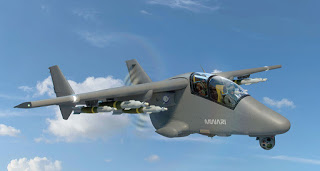Mwari: A plane built for Africa
A credible alternative to Western low-cost aircraft
it can fly for seven hours on internal fuel alone
Mwari: A plane built for Africa.
This beautiful but weird looking plane was designed and built by Paramount company and Boeing for the world market but primarily targeted for the African Market, it was developed to merge both the good attributes and features of a low-cost plane and a helicopter.
Airborne combat planes are usually powerful, heavily armed with various air-to-ground bombs, missiles and guns but don’t let this timid looking aircraft fool you it carries enough munitions to stop a massive armored formation in its tracks. The Mwari design features an unconventional layout so as to enable it undertake a wide variety of roles. It has a pusher-type propeller layout, great visibility and high wing for flight stability.
Mwari is a Southern African all-seeing God of creation which is a good expression of the type of role handled by this aircraft. The Mwari was built on the very successful Advanced High Performance Reconnaissance Light Aircraft (AHRLAC) border patrol plane. The design was released in May 2016 although Paramount and Boeing signed the agreement in September 2014. According to the manufacturers official website, the AHRLAC/Mwari can be used to fulfill so many roles which includes Aircraft Training, Anti-Poaching/Policing, Anti-smuggling, Intelligence-Surveillance- Reconnaissance (ISR) and more importantly Counter-Insurgency operations and Border patrol.
With a crew of two and requiring only 550 meters of space to take-off even if the runway is unpaved, it can carry a large payload or ordnance depending on the role it is undertaking. Its flexibility makes for easy re-configuration on the go allowing it to quickly change into a different operational role. Its patrol radius is very large for such a small aircraft, it can fly for seven hours on internal fuel alone ideal for patrolling borders and coastline without the prohibitive flying costs.
Big powerful fighter jets are usually loved by African Generals and warlords because it signify prestige and strength however, such aircraft are expensive to fly and maintain. In Africa, large conventional military maneuvers are rare this days therefore the need for expensive single role jets have lessened as most African countries cannot keep them flying for a long time- an example is the SAAF Gripens which some has been kept in storage for a long time and has just recently been taken out for flying operations. The Mwari is an excellent platform since it does exactly what Africans type of Low Intensity Combat Warfare (LICW) this tiny aircraft is loaded with the latest advanced sensors that can gather intelligence, intercept signals, relay signals, do day- and night precision attack and can even be used as an airborne Command and Control (C2) while flying from an unprepared environment with minimal operating costs.
‘Through AHRLAC, we’ll not only bring a flexible, persistent and affordable aircraft to the international market, but we’ll also be developing world-class technology in Africa,’ Jeffrey Johnson, vice president, Business Development, Boeing Military Aircraft, said.
Fitted with a Pratt and Whitney PT6 engines the Mwari does not need extensive ground support/infrastructure. If the Mwari is so good then why is nobody queuing up to buy it? Why do they prefer western countries aircraft even though most times it comes with a high price-tag while still under-performing requirement. Such example is the Nigerian Air Force various attempts to buy the Embraer Super Tucano even after the U.S Government has shown its unwillingness to sell the aircraft to Nigeria citing human Rights abuses issues and Kenya’s attempts to buy the American L3’s crop-duster Counter-Insurgent (COIN) aircraft.
Without mincing words, the Mwari is a credible alternative to the Embraer Super Tucano and the L3 AT802U crop duster because unlike the two, the Mwari was designed from the ground up for COIN/LICW while being adaptable and cheaper to operate with advance sensors, ordnance load and flight characteristics.
We’ll see why in the follow-up article. WHY AFRICAN COUNTRIES DO NOT BUY MADE-IN-SOUTH AFRICAN COMBAT SYSTEMS.
Mwari’s SPECIFICATIONS (According to the manufacturer)


